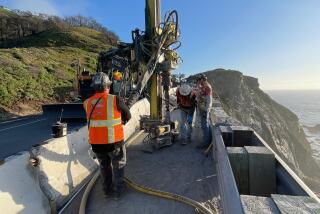Mt. Rainier’s melting glaciers create hazard
- Share via
Reporting from Seattle — The fallout from Mt. Rainier’s shrinking glaciers is beginning to roll downhill, and nowhere is the impact more striking than on the volcano’s west side.
“This is it in spades,” U.S. Park Service geologist Paul Kennard said recently, scrambling up a 10-foot-high mass of dirt and boulders bulldozed back just enough to clear the road.
As receding glaciers expose crumbly slopes, vast amounts of gravel and sediment are being sluiced into the rivers that flow from the region’s tallest peak. Much of the material sweeps down in rain-driven slurries.
“The rivers are filling up with stuff,” Kennard said from his vantage point atop the pile. He pointed out ancient stands of fir and cedar now standing in water.
Inside Mt. Rainier National Park, gravel-choked rivers threaten to spill across roads, overtake bridges and flood the historic park complex at Longmire.
Downstream, communities in King and Pierce counties cast a wary eye at the volcano. As glaciers continue to pull back, the result could be increased flood danger across the Puget Sound lowlands for decades.
“There is significant evidence that things are changing dramatically at Mt. Rainier,” environmental consultant Tim Abbe said. “We need to start planning for it now.”
Similar dynamics are playing out at all of the region’s major glaciated peaks, according to research hydrologist Gordon Grant of the U.S. Forest Service. Climate experts blame global warming, triggered by emissions from industries and cars, for much of the ongoing retreat of glaciers worldwide. North Cascades National Park has lost half of its ice area in the last century. Mt. Rainier’s glaciers have shrunk by more than a quarter.
“Every year it’s been either bad or really bad,” Kennard said. “This year it was really, really bad.”
Glaciers buttress immense moraines and stabilize steep slopes. As they pull back, the vulnerable terrain is exposed to weather and tugged by gravity. All recent debris flows on Mt. Rainier have occurred in recently deglaciated areas, Grant said.
“The whole mountain is covered with unstable debris, it’s steep -- and then you put a lot of water on it,” he said.
Most debris flows are triggered by heavy rain. Climate scientists disagree on whether the entire Northwest is being hit by significantly stronger storms than in the past, but there’s no doubt that’s the case at Mt. Rainier, Kennard said.
Precipitation records show more intense rainfall. According to stream-flow data, what was once a 100-year flood on the Nisqually River now occurs every 14 years. In November 2006, a storm dumped 18 inches of rain on the park in 36 hours, sweeping away a campground and closing the park for more than six months.
Debris flows can carry boulders the size of buses and sweep staggering amounts of gravel and sediment into rivers. The bed of the Nisqually River below its namesake glacier has risen by 38 feet since 1910, largely as a result of debris flows from the margins of the rapidly retreating ice, Kennard said.
The park visitor center at Longmire, with its stone buildings and National Park Inn, sits more than 30 feet below the Nisqually River. The park constructed concrete-reinforced berms to keep the water at bay.
Every riverbed in the park is rising, Kennard said, and the rate of buildup has increased nearly tenfold over the last decade.
Glacial retreat may be aggravating the flow of sediment, but the basic process is as old as the volcano itself. In the past, eruptions have unleashed mud flows that smothered surrounding valleys and reached all the way to Puget Sound.
From the 1930s through the 1980s, Pierce County dredged gravel from the Puyallup River system almost every year to reduce the risk of floods, said Lorin Reinelt, program manager for the county’s flood-management plan.
Most dredging ended by the early 1990s, as concern for fish habitat took precedence. Officials also realized that digging out gravel provides a brief fix at best. “In many cases it just fills back up during the next event,” Reinelt said.
Communities are trying to figure out what rising levels of gravel and sediment from Mt. Rainier will mean for future flood risks -- and what they can do about it.
Short of relocating Longmire, dredging is the only obvious way to keep the river from swallowing the park complex, Kennard said.
Downstream, Reinelt said, a more effective approach might be to move levees back to give the rivers more room to spill their banks, meander and deposit gravel without affecting homes or businesses.
“This is a pretty significant issue,” he said. “It seems like we’re on a trajectory that’s not likely to reverse any time soon.”
Doughton writes for the Seattle Times.
More to Read
Sign up for Essential California
The most important California stories and recommendations in your inbox every morning.
You may occasionally receive promotional content from the Los Angeles Times.












